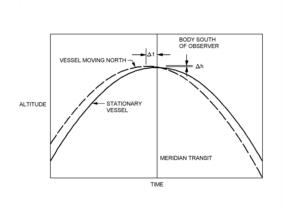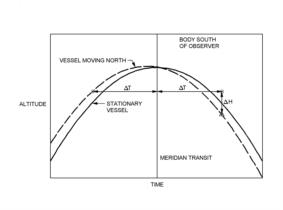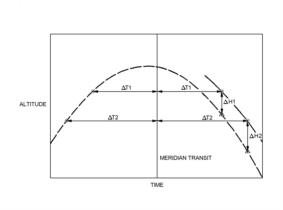
NavList:
A Community Devoted to the Preservation and Practice of Celestial Navigation and Other Methods of Traditional Wayfinding
Re: The Noon Fix
From: James N Wilson
Date: 2009 Jul 10, 20:29 -0700
--~--~---------~--~----~------------~-------~--~----~
NavList message boards: www.fer3.com/arc
Or post by email to: NavList@fer3.com
To , email NavList-@fer3.com
-~----------~----~----~----~------~----~------~--~---
____________________________________________________________
From: James N Wilson
Date: 2009 Jul 10, 20:29 -0700
In reviewing the posts on this subject, everything has been said, at least
once. But explaining a graphical approach with words may not be totally
adequate.
I recently described my method at a Los Angeles Yacht Club Wednesday
luncheon, and knowing that there would be non-navigators there, I prepared an
introduction to help them understand. I still got a lot of blank looks, but I'll
show what I did, in case everyone on the list doesn't completely understand the
method.
I introduced the double altitude method, showing the slide Myth,
noting that it is very simple and often quoted. But it doesn't work on a moving
vessel, and if you're standing on a rock during one of the solstices when it
does work, it really isn't needed.
I followed with the slide, Problem, showing the effect of vessel
motion. This is taken from my Navigation paper. It shows that
north-south motion affects the time of highest altitude. In that paper, I
concentrated on determining Dt so as to correct for this effect. I noted that the
change in maximum altitude Dh is insignificant.
I then showed the slide, Solution, which illustrates the
principle, and shows how to determine when to commence taking the last run of
sights. That method is to calculate the time between the last sight of the first
run and meridian transit, DT, and then adding it to that time. I explained that
DH is the consequence of
north-south movement (and declination change). As such, it is directly related
to the time between observations, 2xDT.
I then worked the example to demonstrate the method.
For this group, I'll add two more slides. To properly bracket actual
observations, another value of DH is needed. Solution1 adds a second
determination of it based on the first observation of the initial run of sights.
From these two values, the corrected (solid) curve can be obtained.
Now all of this is based on having a robot working the problem. He knows
exactly where he is, and his sights are taken precisely at the theoretical time
and need no correction. So, he doesn't need the data, but is working just to
please us. But he does illustrate the principle, and one could imagine working
backwards with a set of real and imperfect data.
The next slide, Solution2, has translated the right hand portion
of Solution1 to where it overlaps the left part, allowing the lines to
intersect. This is for the convenience of the user, and I make DWT a whole number of
minutes as a plotting convenience. No error is introduced here, and DWT consequently falls somewhere
in the middle ranges of the sight data. I further calculate only one value of
Dhs as a simplification.
This does introduce some error, but since DWT has already been shown to be close to the intersection
of the ascending altitude line and the adjusted descending line, the resultant
error is small. This slide will be recognized as the example plot, with only one
value of Dhs
calculated.
Hopefully, this will make the method more understandable.
Thanks.
Jim Wilson
--~--~---------~--~----~------------~-------~--~----~
NavList message boards: www.fer3.com/arc
Or post by email to: NavList@fer3.com
To , email NavList-@fer3.com
-~----------~----~----~----~------~----~------~--~---
____________________________________________________________











